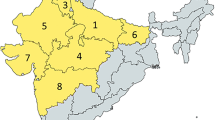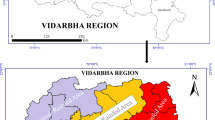Abstract
We use regression analysis on data from 208 districts over the period 1981–2009 to examine the impact of temperature and solar radiation (affected by pollution from aerosols) on wheat yields in India. We find that a 1 °C increase in average daily maximum and minimum temperatures tends to lower yields by 2–4% each. A 1% increase in solar radiation increases yields by nearly 1%. Yields are estimated to be about 5.2% lower than they would have been if temperatures had not increased during the study period. We combine the estimated impacts of weather on yield with the estimated impacts of aerosol pollution (measured by moderate resolution imaging spectroradiometer sensor in terms of aerosol optical depth, aerosol optical depth (AOD) in 2001–2013) on weather to compute the net impact of reducing aerosol pollution on wheat yields. A one-standard-deviation decrease in AOD is estimated to increase yields by about 4.8%. Our results imply reducing regional pollution and curbing global warming in the coming decades can counter wheat yield losses.


Similar content being viewed by others
Notes
These are the weighted averages of the increases in all sample districts where the weights are proportional to wheat production in 2009.
To be precise, rather than using observed temperatures in 1981 and 2009, we use predicted temperatures for those years from district-specific regressions of maximum and minimum temperature on year. This is done in order to avoid any noise introduced by the possibility that the years 1981 and 2009 were unusually hot or cold.
References
Burney J, Ramanathan V (2014) Recent climate and air pollution impacts on Indian agriculture. Proc Natl Acad Sci U S A 111(46):16319–16324
Chameides W, Yu H, Liu S, Bergin M, Zhou X, Mearns L, Wang G, Kiang C, Saylor R, Luo C et al (1999) Case study of the effects of atmospheric aerosols and regional haze on agriculture: an opportunity to enhance crop yields in China through emission controls? Proc Natl Acad Sci U S A 96(24):13626–13633
Conley TG (2008) Spatial econometrics. In: Durlauf SN, Blume LE (eds) The new palgrave dictionary of economics. Palgrave Macmillan, Basingstoke
Driscoll JC, Kraay AC (1998) Consistent covariance matrix estimation with spatially dependent panel data. Rev Econ Stat 80(4):549–560
FAO (n.d.a). FAO, Food and Agriculture Organisation. URL: http://faostat3.fao.org/browse/Q/QC/E
FAO (n.d.b). FAO, Food and Agriculture Organisation. URL: http://faostat3.fao.org/download/P/PP/E
Hoechle D (2007) Robust standard errors for panel regressions with cross-sectional dependence. Stata J 7(3):281
Hsiang SM (2010) Temperatures and cyclones strongly associated with economic production in the Caribbean and Central America. Proc Natl Acad Sci U S A 107(35):15367–15372
Huang Y, Dickinson RE, Chameides WL (2006) Impact of aerosol indirect effect on surface temperature over East Asia. Proc Natl Acad Sci U S A 103(12):4371–4376
Lobell DB, Schlenker W, Costa-Roberts J (2011) Climate trends and global crop production since 1980. Science 333(6042):616–620
Ocean, N. and Administration, A. (n.d.). NOAA. URL: http://www.esrl.noaa.gov/gmd/grad/surfrad/aod/
Padma Kumari, B., Londhe, A., Daniel, S. and Jadhav, D. (2007). Observational evidence of solar dimming: offsetting surface warming over India, Geophysical Research Letters 34(21)
Rathore, L., Attri, S. and Jaswal, A (2013) State level climate change trends in India, Technical Report ESSO/IMD/EMRC/02/2013, Indian Meteorological De- partment
Ruosteenoja, K. and Ra¨isa¨nen, J (2009) Solar radiation projections derived from global climate models (part of ces deliverable d2. 4)
Sanap S, Ayantika D, Pandithurai G, Niranjan K (2014) Assessment of the aerosol distribution over Indian subcontinent in CMIP5 models. Atmos Environ 87:123–137
Schlenker W, Roberts MJ (2009) Nonlinear temperature effects indicate severe damages to US crop yields under climate change. Proc Natl Acad Sci U S A 106(37):15594–15598
Wardlaw I, Moncur L (1995) The response of wheat to high temperature following anthesis. I. The rate and duration of kernel filling. Funct Plant Biol 22(3):391–397
Welch JR, Vincent JR, Auffhammer M, Moya PF, Dobermann A, Dawe D (2010) Rice yields in tropical/subtropical Asia exhibit large but opposing sensitivities to minimum and maximum temperatures. Proc Natl Acad Sci U S A 107(33):14562–14567
Acknowledgments
Sagnik Dey acknowledges funding from the Department of Science and Technology, Govt. of India (DST/CCP/PR/11/2011) through a research project operational at IIT Delhi (IITD/IRD/RP2580).
Author information
Authors and Affiliations
Corresponding author
Electronic supplementary material
Below is the link to the electronic supplementary material.
ESM 1
(PDF 139 kb)
Rights and permissions
About this article
Cite this article
Gupta, R., Somanathan, E. & Dey, S. Global warming and local air pollution have reduced wheat yields in India. Climatic Change 140, 593–604 (2017). https://doi.org/10.1007/s10584-016-1878-8
Received:
Accepted:
Published:
Issue Date:
DOI: https://doi.org/10.1007/s10584-016-1878-8




